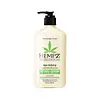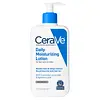Hempz Age-Defying Herbal Body Moisturizer Versus CeraVe Daily Moisturizing Lotion Normal To Dry Skin
What's inside
What's inside
 Key Ingredients
Key Ingredients

 Benefits
Benefits

 Concerns
Concerns

 Ingredients Side-by-side
Ingredients Side-by-side

Water
Skin ConditioningIsopropyl Palmitate
EmollientButylene Glycol
HumectantPropanediol
SolventGlycerin
HumectantButyrospermum Parkii Butter
Skin ConditioningDimethicone
EmollientParfum
MaskingSorbitan Stearate
EmulsifyingStearic Acid
CleansingGlyceryl Stearate
EmollientPEG-100 Stearate
Cannabis Sativa Seed Oil
EmollientAlthaea Officinalis Root Extract
Skin ConditioningLaminaria Digitata Extract
Skin ProtectingPanax Ginseng Root Extract
EmollientSymphytum Officinale Leaf Extract
Skin ConditioningCaffeine
Skin ConditioningRetinyl Palmitate
Skin ConditioningChamomilla Recutita Flower Extract
MaskingCucumis Sativus Fruit Extract
EmollientAlaria Esculenta Extract
Skin ProtectingHelianthus Annuus Seed Oil
EmollientAloe Barbadensis Leaf Juice
Skin ConditioningPhenoxyethanol
PreservativeCetyl Alcohol
EmollientPolysorbate 40
EmulsifyingCarbomer
Emulsion StabilisingBenzyl Benzoate
AntimicrobialNylon-12
Chlorphenesin
AntimicrobialAminomethyl Propanol
BufferingEthylhexylglycerin
Skin ConditioningDisodium EDTA
Hexyl Cinnamal
PerfumingAlpha-Isomethyl Ionone
PerfumingTocopherol
AntioxidantCoumarin
PerfumingTocopheryl Acetate
AntioxidantCI 19140
Cosmetic ColorantAscorbic Acid
AntioxidantDipalmitoyl Hydroxyproline
Skin ConditioningCI 15985
Cosmetic ColorantCitric Acid
BufferingSodium Lactate
BufferingPolysorbate 20
EmulsifyingPotassium Sorbate
PreservativeSodium Benzoate
MaskingPalmitoyl Pentapeptide-4
Skin ConditioningWater, Isopropyl Palmitate, Butylene Glycol, Propanediol, Glycerin, Butyrospermum Parkii Butter, Dimethicone, Parfum, Sorbitan Stearate, Stearic Acid, Glyceryl Stearate, PEG-100 Stearate, Cannabis Sativa Seed Oil, Althaea Officinalis Root Extract, Laminaria Digitata Extract, Panax Ginseng Root Extract, Symphytum Officinale Leaf Extract, Caffeine, Retinyl Palmitate, Chamomilla Recutita Flower Extract, Cucumis Sativus Fruit Extract, Alaria Esculenta Extract, Helianthus Annuus Seed Oil, Aloe Barbadensis Leaf Juice, Phenoxyethanol, Cetyl Alcohol, Polysorbate 40, Carbomer, Benzyl Benzoate, Nylon-12, Chlorphenesin, Aminomethyl Propanol, Ethylhexylglycerin, Disodium EDTA, Hexyl Cinnamal, Alpha-Isomethyl Ionone, Tocopherol, Coumarin, Tocopheryl Acetate, CI 19140, Ascorbic Acid, Dipalmitoyl Hydroxyproline, CI 15985, Citric Acid, Sodium Lactate, Polysorbate 20, Potassium Sorbate, Sodium Benzoate, Palmitoyl Pentapeptide-4
Water
Skin ConditioningGlycerin
HumectantCaprylic/Capric Triglyceride
MaskingCetearyl Alcohol
EmollientCetyl Alcohol
EmollientPotassium Phosphate
BufferingCeramide NP
Skin ConditioningCeramide AP
Skin ConditioningCeramide EOP
Skin ConditioningCarbomer
Emulsion StabilisingDimethicone
EmollientCeteareth-20
CleansingBehentrimonium Methosulfate
Methylparaben
PreservativeSodium Lauroyl Lactylate
EmulsifyingCholesterol
EmollientDisodium EDTA
Dipotassium Phosphate
BufferingPropylparaben
PreservativeHydrolyzed Hyaluronic Acid
HumectantPhytosphingosine
Skin ConditioningXanthan Gum
EmulsifyingPolysorbate 20
EmulsifyingPolyglyceryl-3 Diisostearate
EmulsifyingWater, Glycerin, Caprylic/Capric Triglyceride, Cetearyl Alcohol, Cetyl Alcohol, Potassium Phosphate, Ceramide NP, Ceramide AP, Ceramide EOP, Carbomer, Dimethicone, Ceteareth-20, Behentrimonium Methosulfate, Methylparaben, Sodium Lauroyl Lactylate, Cholesterol, Disodium EDTA, Dipotassium Phosphate, Propylparaben, Hydrolyzed Hyaluronic Acid, Phytosphingosine, Xanthan Gum, Polysorbate 20, Polyglyceryl-3 Diisostearate
 Reviews
Reviews

Ingredients Explained
These ingredients are found in both products.
Ingredients higher up in an ingredient list are typically present in a larger amount.
Carbomer is a polymer of acrylic acid. Its main role is to create a gel consistency.
A high amount of carbomer can cause pilling or balling up of products. Don't worry, most products contain 1% or less of carbomer.
Cetyl Alcohol is a fatty alcohol. Fatty Alcohols are most often used as an emollient or to thicken a product.
Its main roles are:
Though it has "alcohol" in the name, it is not related to denatured alcohol or ethyl alcohol.
The FDA allows products labeled "alcohol-free" to have fatty alcohols.
Learn more about Cetyl AlcoholDimethicone is a type of synthetic silicone created from natural materials such as quartz.
What it does:
Dimethicone comes in different viscosities:
Depending on the viscosity, dimethicone has different properties.
Ingredients lists don't always show which type is used, so we recommend reaching out to the brand if you have questions about the viscosity.
This ingredient is unlikely to cause irritation because it does not get absorbed into skin. However, people with silicone allergies should be careful about using this ingredient.
Note: Dimethicone may contribute to pilling. This is because it is not oil or water soluble, so pilling may occur when layered with products. When mixed with heavy oils in a formula, the outcome is also quite greasy.
Learn more about DimethiconeDisodium EDTA plays a role in making products more stable by aiding other preservatives.
It is a chelating agent, meaning it neutralizes metal ions that may be found in a product.
Disodium EDTA is a salt of edetic acid and is found to be safe in cosmetic ingredients.
Learn more about Disodium EDTAGlycerin is already naturally found in your skin. It helps moisturize and protect your skin.
A study from 2016 found glycerin to be more effective as a humectant than AHAs and hyaluronic acid.
As a humectant, it helps the skin stay hydrated by pulling moisture to your skin. The low molecular weight of glycerin allows it to pull moisture into the deeper layers of your skin.
Hydrated skin improves your skin barrier; Your skin barrier helps protect against irritants and bacteria.
Glycerin has also been found to have antimicrobial and antiviral properties. Due to these properties, glycerin is often used in wound and burn treatments.
In cosmetics, glycerin is usually derived from plants such as soybean or palm. However, it can also be sourced from animals, such as tallow or animal fat.
This ingredient is organic, colorless, odorless, and non-toxic.
Glycerin is the name for this ingredient in American English. British English uses Glycerol/Glycerine.
Learn more about GlycerinPolysorbate 20 is made by combining ethoxylation of sorbitan, ethylene oxide, and lauric acid. It is a mild cleansing agent, surfactant, and emulsifier.
As a surfactant, it helps collect dirt and oils for washing. Emulsifiers prevent oils and water from separating.
Polysorbate 20 also adds scent to a product. Since it is made using sorbitol, it has a sweet scent. Sorbitol can also be found in fruits such as apples and peaches.
The lauric acid used to create Polysorbate 20 is often derived from coconuts.
Polysorbate 20 may not be fungal acne safe.
Learn more about Polysorbate 20Water. It's the most common cosmetic ingredient of all. You'll usually see it at the top of ingredient lists, meaning that it makes up the largest part of the product.
So why is it so popular? Water most often acts as a solvent - this means that it helps dissolve other ingredients into the formulation.
You'll also recognize water as that liquid we all need to stay alive. If you see this, drink a glass of water. Stay hydrated!
Learn more about Water